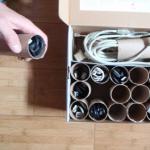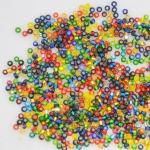How does synthetic material burn? Synthetic fibers
It is usually not difficult to distinguish synthetic fabric from natural fabric in a store. Just read the composition of the material on the price tag, or ask the seller. In addition, natural fabrics are often much more expensive than synthetics. However, there are quite a lot of situations where the composition of the tissue is unknown. How can you find out what the fabric is made of? Read under the cut.
Serious doubts regarding the composition of the fabric may arise if you buy a piece secondhand, or if you discover large deposits of fabric of unknown origin at home. :) Sometimes I doubt the composition of the fabric even in the store. For example, if the cotton feels too silky or stretchy. Or if it doesn't wrinkle at all.
But why so scrupulously find out the true composition of the material? Firstly, to understand whether the price of the fabric you have chosen is adequate. And secondly, many people prefer to wear only natural fabrics. I am one of them. I feel hot in synthetics, but the worst thing is allergic reactions. Of course, there must be an integrated approach, and nutrition, as well as cosmetics, should also be as natural as possible. But clothing can be a big factor in combating unpleasant skin reactions.
In my opinion, with experience, many fabrics can be identified by touch. For example, natural wool has a very recognizable smell, and silk is easy to recognize by touch. But, of course, you can always run into a very well-made synthetic fabric. How to determine the composition of the fabric? For this we need... Matches or a lighter. Yes, yes, we will check the composition of the fabric this old-fashioned way.
For my experiment I selected:
Viscose lining fabric.
Unnamed fabric, synthetic in my opinion.
Unnamed chiffon, similar to synthetics.
Let's start the experiment. General rule for all natural fabrics: the ashes should be ground into powder. The ashes of mixed fabrics cannot be ground into powder; lumps will still remain between your fingers.
How should wool behave?
The wool curls up into a ball and emits a burnt lint smell.
Result: I admit that wool was the most difficult for me. Since almost all wool was added, this slightly changed the reaction of the fabric to ignition. And, as you can see, the ashes were not ground into powder.
Cotton should burn like paper.
Result: a piece of fabric caught fire like paper, the ashes were perfectly ground into powder. Confirming the composition of the cotton was very simple.
The burning silk should “jump” above the match and not emit any odor.
The chemical industry produces a large number of chemical fibers used to make clothing and other goods. When degreasing with chlorinated hydrocarbons, some of the fibers may be completely or partially dissolved, such as fibers obtained from vinyl chloride. Some types of products undergo such shrinkage during the degreasing process that they completely lose consumer properties: for example, a size 48 jersey becomes a size 30. Products made from silk acetate may be destroyed during the process by the use of acetone, acetic acid and other reagents. All this made it necessary to recognize fibrous composition products.
Fibers can be recognized by the nature of their combustion, by their solubility in various solvents, by their dyeability, as well as by their melting point, fluorescence and luminescence.
When examining fibers using a microscope, they are examined both in the longitudinal and transverse directions (transverse sections), comparing those studied with standards.
Despite the fact that there are many fiber recognition methods, most of them are unsuitable for work in factories, as they require a significant investment of time, large samples of the materials being studied, or the use of special equipment.
Express fiber recognition methods applicable to collection points and dry cleaning factories
Recognition of fabric fibers by combustion pattern
The method of recognizing fibers by burning them is the simplest. Using it, you can identify a whole range of fibers quite accurately. When burning fibers in the flame of an alcohol lamp or burner, they take into account the nature of combustion (quiet flame or combustion accompanied by melting), the type of flame (smoking or not), the smell, the type of residue after combustion, and then make a conclusion about whether the fibers belong to one class or another.
|
Sunbathing |
Character |
Behavior outside the flame |
Smell when burning |
Character |
|
|
Cotton, viscose fiber |
Burn quickly without soot or melting |
Gray ash |
|||
|
Natural silk, wool |
Burn moderately without soot or melting |
Fragile black ball |
|||
|
Acetate |
Burns moderately, without soot, melts |
Vinegar |
Dark brown ball |
||
|
Nylon, nylon |
Burn moderately without soot, melt |
Hard, dark, shiny ball |
|||
|
Burns quickly with soot and melting |
|||||
|
doesn't melt |
Dark, matte, loose ball |
||||
|
Polypropylene |
Burns quickly, without soot, melts |
Non-fragile black ball |
|||
|
with soot and melting |
Fragile black ball |
Recognition of fabric fibers by solubility
Fibers can also be recognized by their solubility in different solvents.
|
Processing sequence |
Solvent |
||
|
dissolve |
Do not dissolve |
||
|
Doorman's Reagent |
Viscose, copper-ammonia |
Acetate, polyester, polyamide, polyvinyl chloride, polyacrylonitrile |
|
|
Acetic acid, glacial, cold |
Acetate |
Polyester, polyamide, polyvinyl chloride, polyacrylonitrile |
|
|
Hydrochloric acid cold |
Nylon, anide (when the solution is diluted with water, a precipitate forms) |
Polyamide (undecane), polyester, polyvinyl chloride, polyacrylonitrile |
|
|
Nitric acid, concentrated cold |
Polyacrylonitrile (nitron) |
Polyamide (undecane), polyester, polyvinyl chloride |
|
|
Concentrated cold sulfuric acid |
Polyamide (undecane), polyester (lavsan) |
Polyvinyl chloride (chlorine) |
|
Recognition of fabric fibers by dyeability
For undyed fibers, it is possible to recognize fibers by their dyeability in a dye mixture. The mixture is prepared by dissolving the following dyes in 1 liter of water, g:
Chloramine orange 1.0
Chloramine yellow 2.0
Diamond blue FFR extra 1.0
Eosin extra 1.0
Cellitone pink R 0.5
Dispersant 1.0
Celliton pink R is dissolved in water at 50-60° C. The remaining dyes are dissolved at boiling. The fiber sample to be analyzed is placed in a boiling dye solution for 3 minutes. Samples are then selected, washed with cold water and boiled in a bath containing 1 g/L dispersant for 1 min. As a result of dyeing, the fibers obtain the following color:
|
Natural silk |
|
|
Woolen |
Dark purple |
|
Cotton |
Gray-yellow |
|
Casein |
Red-violet |
|
Mercerized cotton |
Bright yellow |
|
Copper-ammonia |
Orange-brown |
|
Acetate |
|
|
Polyamide |
|
|
Polyvinyl chloride |
Colorless |
There are also methods from NITHIB and MIT.
Nylon is a polyamide fiber.
- Nylon is a strong fiber (45 – 70 CH/tex).
· In terms of strength it is second only to glass. When wet, the strength does not decrease (10 - 15%).
· Elongation is 20-25%, when wet it increases by 3-5%.
· Elasticity is a distinctive feature of p/a fibers: with small tensile forces, the reverse deformation of nylon is 90-95% of the total elongation.
· Nylon is characterized by very high resistance to abrasion and repeated deformation. The abrasion resistance of nylon is taken as 100%.
· The heat resistance of nylon is low t=65 0 C, t 100-110 0 C.
· The light resistance of nylon is also insufficient; to increase heat and light resistance, stabilizers are added to the composition of polyamides.
· Chemoresistant. Withstands acids and alkalis up to medium concentrations.
· Resistant to microorganisms.
The disadvantages of nylon include low hygroscopicity (4-5%), reduced adhesion, poor colorability, increased rigidity and electrification.
Combustion . When brought to the flame, it melts, then lights up with a weak bluish-yellow flame, spreading white smoke and the smell of sealing wax. When removed from the flame, the combustion stops and a solid gray ball solidifies at the end.
MODIFICATIONS OF P/A FIBERS
SHELON-1– is a profiled thread with a complex cross-sectional shape, which makes it possible to create open channels (capillaries) and porosity in the thread. This thread structure significantly improves its hygroscopic properties. Fabrics made from Shelon-1 threads are close in their properties to fabrics from natural silk. Products made from them are pleasant to wear and do not cause skin irritation, because... porous fiber provides good ventilation.
TRILOBAL– physically modified complex-profile polyamide thread. Gives products softness, silkiness, increased porosity, which increases the breathability and moisture conductivity of materials.
CAPRYLON AND MEGALON– chemically modified polya fibers, which are obtained by side grafting of a copolymer containing hydroxylone groups. Such fibers are close to cotton in hygroscopicity (5-7%) and surpass it in strength and abrasion resistance. The susceptibility of fibers to dyes is increased.
LAVSAN
Lavsan – polyester fiber
The starting material for its production, polyethylene terephthalate, is a product of the interaction of dimethyl terephthalate and ethylene glycol.
- Lavsan is a strong fiber. The breaking load of conventional fibers reaches 40-50 CH/tex. When wet, the strength remains virtually unchanged.
- The elongation is 20-25%.
- The fibers are highly elastic: when stretched up to 5-6%, the elongation is completely reversible, so lavsan fabrics do not wrinkle after washing and cleaning. Lavsan is the most elastic fiber.
- Lavsan is highly resistant to abrasion (second only to polyamide fibers).
- The fiber is resistant to light. It is also positive that when exposed to light, products made from polyethylene fibers do not change their color to the same extent as others.
- The fiber is heat-resistant, t=180 0 C, tto=140-160 0 C.
- Resistance to acids and oxidizing agents is higher for polyester fibers than for polyamide fibers. However, the fibers are not sufficiently resistant to alkalis, especially when heated.
- Lavsan has a slight shrinkage, so the products have a stable shape.
- Has high dielectric properties.
- Resistant to microorganisms.
DISADVANTAGES: low hygroscopicity (0.5%), high electrification, poor paintability, pilling.
Combustion : When brought to a flame, it shrinks, melts, then ignites. Burns with a calm yellowish flame with the release of black soot. A hard black ball hardens at the end.
MODIFICATIONS: complex-profile polyethylene thread shelon-2.
NITRON
Nitron – polyacrylonitrile fiber (PAN). It is obtained mainly in the form of staple fiber.
Nitron is a very light, soft, wool-like fiber that has low thermal conductivity, the indicators of which are close to the thermal conductivity of wool. Nitron is inert to pollutants, so products are easy to clean.
· Nitron – strong fiber (32-39 CH/tex). Due to low hygroscopicity in the wet state, strength almost does not lose (2-5%).
· Elongation depends on the degree of drawing and ranges from 16 to 35%.
· Good elastic properties.
· Nitron is the most light-resistant fiber. After a year of aging in the open air, nitron retains 80% of its strength, and cotton - 5%.
· Heat resistance 180 0 C, t WTO = 140-160 0 C.
· The fiber is resistant to microorganisms and is not damaged by moths.
· Nitron is resistant to oxidizing agents and organic acids, but unstable to concentrated solutions of alkalis and inorganic acids.
Disadvantages include:
· Low hygroscopicity (2%).
· Poor colorability.
· Low abrasion resistance.
· Significant electrification and pillability.
Combustion : When brought to the flame, it first shrinks, melts, then burns intensely, in flashes, releasing a large amount of black soot. After the combustion stops, an irregularly shaped influx remains.
Compared to other synthetic fibers, nitron has the advantage of being easy to modify, which makes it possible to give them specific properties over a wide range: dyeability with dyes of various classes, antistatic, non-flammable, porous, transparent, increased strength, stable crimp, adhesion (scaly fibers), etc. d.
CHLORINE
Chlorine refers to polyvinyl chloride fibers. The raw material is vinyl chloride, obtained from ethylene or acetylene by saturating them with chlorine.
Chlorine differs from other chemical fibers in its lack of shine.
· Has less strength than other synthetic fibers. When wet, the strength does not decrease.
· Elasticity is lower than other synthetic fibers.
· Low heat resistance (t=70 0 C), when heated to t=90-100 0 C, the fiber begins to deform.
· Low light fastness.
· Non-hygroscopic fiber (0.1%).
· High chemical resistance. Chlorine is the most chemical-resistant fiber (dissolves in chloroform and perchlorethylene).
Combustion The fiber is non-flammable. When brought to the flame, it shrinks greatly, chars, but does not burn, and emits the smell of chlorine.
Application
1. Therapeutic underwear for patients with rheumatism and radiculitis (since chlorine is capable of accumulating electrical charges on its surface).
2. Overalls for workers in the chemical industry (since the fiber is very chemical resistant).
3. Overalls for fishermen and foresters (since chlorine is resistant to microorganisms and does not absorb water).
VINOL
Vinol belongs to the class of polyvinyl alcohol fibers.
Polyvinyl alcohol fibers are produced in small quantities. They are produced in the form of staples (for household products), high-strength threads for technical purposes and special-purpose fibers - water-soluble, ion-exchange, bactericidal.
· A special feature of vinol is its high hygroscopicity (8%), due to the large number of hydroxyl groups, and good colorability.
· Vinol is a strong fiber (30-40 CH/tex).
· Elongation of regular staple fiber is 30-35%.
· Satisfactory elastic properties.
· High abrasion resistance (vinol is second only to polyamide fibers in this indicator).
· Heat-resistant fiber (t=180 0 C). Withstands boiling washing, hot ironing, and dries quickly.
· Thermal conductivity is close to wool.
· Light fastness is good.
· Under the influence of water, strength decreases by 15-25%.
· Resistant to alkalis, but strength decreases when heated.
· Dissolves in concentrated acid solutions in the cold.
When introduced into the flame, it shrinks, then burns with a yellowish flame. After the combustion stops, a solid influx of light brown color remains.
SPANDEX (LYCRA)
Spandex is a polyurethane fiber.
Distinctive feature polyurethane threads – their high elasticity (elongation at break can be 800%). When elongated by 300%, the proportion of elastic elongation is 92-98%. Polyurethane threads give textile materials high elasticity, resilience, dimensional stability, and wrinkle resistance. They are highly resistant to abrasion, mold and sweat, are easy to paint, and are resistant to chemicals and light weather.
However, spandex fibers have a low breaking load, are not hygroscopic (0.8-0.9%), and have low heat resistance (80-100 0 C). When heated to 150 0 C, thermal destruction begins, the threads turn yellow, and their rigidity increases.
They burn like lavsan.
Application. Polyurethane threads are used to make elastic fabrics and knitwear. They act as frame rods around which threads from other fibers are wound.
Everyone knows that fabrics come in different compositions. They can be combined into three groups - natural, non-natural, mixed. Fabrics from natural fibers made from natural raw materials - cotton, linen, silk, wool, etc. Viscose can also be classified as a natural fabric.
Non-natural fabrics are made from chemically produced fibers - acetate, polyester, nylon, lavsan, nylon, etc. Blended fabrics may contain several fibers of different origins. Thanks to the latest technologies synthetic fabrics do not differ in appearance from natural fabrics, but knowing the composition of the fabric is very important in order to know how the fabric will behave in the product and how to care for it. Today we will talk about how to determine the composition of fabric by burning.
Cotton and linen. Fibers of plant origin. Cotton from the cotton plant, flax from the flax ear. The fibers burn quickly with a bright flame followed by a glow and a small amount of white smoke. After the flames die out, they smolder for a long time, producing dark gray ash and the smell of burnt paper. Flax smolders worse and dies out faster, leaving virtually no ash or pungent odor.
Cotton


Linen



Natural viscose .
They are made from wood, or rather from cellulose, and from it they produce viscose. This fiber has all the properties of cotton, although it is produced chemically; viscose can safely be classified as a natural fabric. So, it burns very quickly. When the flame dies out, it smolders for a very long time, forming a pungent, thick smell of burnt cotton wool, leaving gray smoke and ash that easily crumbles in your hands.
Viscose




Wool and silk. Animal fibers. Wool is produced from the hair of animals, and in the production of silk, threads produced by the silkworm are used. When burned, these fibers behave the same. They burn slowly, the fibers seem to curl up. Silk without a flame goes out immediately. Wool, after fading, does not smolder. The resulting coal can be easily crushed with your fingers. When wool burns, the smell is like burnt hair or feathers; when silk burns, it smells like burnt horn.
Wool



Silk



Synthetic materials. The initial raw materials for production are oil and gas processing materials (types of fibers - polyamide, polyvinyl chloride, polyester, etc.). Obtained chemically. What they have in common is that when they burn, they melt, forming black smoke and an influx, sintering into a lump that cannot be crushed with your fingers after extinguishing. Distribute sour smell synthetics.
Polyester



Acetate and acrylic fabrics. They burn and melt both in the flame and outside the flame. They also leave behind a dark influx and a hard lump. For example, acetate fiber It also dissolves in acetone.
Blended fabrics. They will burn the same way as the predominant fiber in the composition burns. For example, if the fabric is wool with the addition of lavsan, then it will smell like wool, but the lump will not completely crumble after it fades.
Today there is a wide variety of materials. They differ in the way the threads are interwoven - warp and weft, the characteristics of the warp used, and processing options. The result is canvases that differ in texture, appearance, and technical and operational characteristics. Many natural materials have been replaced by synthetic ones with improved properties. It is important to be able to understand the compositions in order to use each type of product for its intended purpose.
Based on raw materials, all types of fabrics are divided into:
- Natural - fibers of plant or animal origin are used as a base - cotton, linen, wool, silk. Using different weaves of threads, calico, flannel, poplin, chintz, and waffle fabric are obtained.
- Artificial - produced from organic and inorganic bases - cellulose, protein, glass, metal. These include modal, lurex, viscose, acetate, and fabrics with metallic inclusions.
- Synthetic - created from polymers - polyesters, polyamides, polyvinyls and polypropylenes. They get satin, elastane, lycra.
By combining natural and artificial fibers, many modern materials are produced that combine all the best from the first and second - polycotton, polysatin.
When purchasing canvases from a trusted, reliable place, you can safely trust the label and the words of the seller. Typically, the product you purchase will indicate what fiber it is made from, along with the percentage of each component. In addition, the cost of natural ones is generally higher than synthetic ones. Many unscrupulous sellers offer items made from artificial fibers, passing them off as natural, in order to get more revenue. This is why it is so important to know how to determine the composition of a fabric.
How to distinguish natural fabric from synthetic
There are several ways to help determine the origin of matter. Experienced needlewomen install the raw materials used according to appearance, tactile sensations, wrinkleability of things. A universal method that does not require special skills and knowledge - due to the nature of the flap burning. You should take a small piece and set it on fire; you can determine its naturalness by the flame and smell:
- Plant fibers burn quickly, with a bright fire, and the smell of burnt paper is felt in the process.
- Threads of animal origin burn slowly, without flame, emitting the smell of burnt hair.
- Non-natural materials do not burn, but smolder, after which a solid lump remains instead of ash.
To determine whether the canvas is acetate, dip the flap in a solution with nail polish. The man-made fibers will be destroyed.






